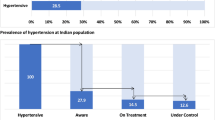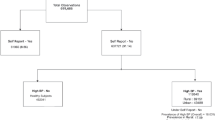Abstract
Hypertension is the most important risk factor for chronic disease burden in India. Studies from various parts of India have reported high prevalence of hypertension. These studies have also reported that hypertension is increasing and there is low awareness and control. Two recent studies have been conducted with uniform tools and nationwide sampling to determine the true prevalence of hypertension in the country. Fourth National Family Health Survey evaluated hypertension in a large population based sample (n = 799,228) and reported hypertension in 13.8% men vs. 8.8% women (overall 11.3%) aged 15–49 and 15–54 respectively. More representative data (age > 18 years, n = 1,320,555) in Fourth District Level Household Survey reported hypertension in 25.3% with greater prevalence in men (27.4%) than women (20.0%). This translates into 207 million persons (men 112 million, women 95 million) with hypertension in India. Prevalence would be much higher using 2017 American guidelines. Global Burden of Diseases study reported that hypertension led to 1.63 million deaths in India in 2016 as compared to 0.78 million in 1990 (+108%). The disease burden (DALYs) attributable to hypertension increased from 21 million in 1990 to 39 million in 2016 (+89%). Social determinants of hypertension are important and Indian states with greater urbanization, human development and social development have more hypertension. There is poor association of hypertension prevalence with healthcare availability although there is positive association with healthcare access and quality. The health system in India should focus on better hypertension screening and control to reduce cardiovascular morbidity and mortality.
This is a preview of subscription content, access via your institution
Access options
Subscribe to this journal
Receive 12 digital issues and online access to articles
$119.00 per year
only $9.92 per issue
Buy this article
- Purchase on Springer Link
- Instant access to full article PDF
Prices may be subject to local taxes which are calculated during checkout







Similar content being viewed by others
References
GBD 2016 Risk Factors Collaborators. Global, regional, and national comparative risk assessment of 84 behavioral, environmental and occupational, and metabolic risks or clusters of risks, 1990-2016: a systematic analysis for the Global Burden of Disease Study 2016. Lancet 2017; 1345–422.
Gupta R, Xavier D Hypertension: the most important non-communicable disease risk factor in India. Indian Heart J. 2018; 10.1016/j.ihj.2018.02.003.
World Health Organization. Global Status Report on Non-Communicable Diseases 2014. Geneva: World Health Organization. 2014.
Farouzanfar MH, Ng M, Biryukov S, Roth GA, Alexander L, Liu P, et al. Global burden of hypertension and systolic blood pressure of at least 110 to 115 mm Hg, 1990-2015. JAMA. 2017;317:175–82.
NCD Risk Factor Collaboration (NCD-RiSC). Worldwide trends in blood pressure from 1975 to 2015: a pooled analysis of 1479 population-based measurement studies with 19.1 million participants. Lancet. 2017; 389:37–55.
Gupta R, Al-Odat NA, Gupta VP. Hypertension epidemiology in India: Meta-analysis of fifty-year prevalence rates and blood pressure trends. J Hum Hypertens. 1996;10:465–72.
Gupta R. Trends in hypertension epidemiology in India. J Hum Hypertens. 2004;18:73–78.
Anchala R, Kannuri NK, Pant H, Khan H, Franco OH, Angelantonio E, et al. Hypertension in India: a systematic review and meta-analysis of prevalence, awareness, and control of hypertension. J Hypertens. 2014;32:1170–7.
Gupta R. Convergence in urban-rural prevalence of hypertension in India. J Hum Hypertens. 2016;30:79–82.
Whelton PK, Carey RM, Aronow WS, Casey DE Jr, Collins KJ, Dennison Himmelfarb C, et al. ACC/AHA/AAPA/ABS/ACPM/AGS/APhA/ASH/ASPC/NMA/PCNA guideline for the prevention, detection, evaluation and management of high blood pressure in adults: executive summary. J Am Coll Cardiol. 2017;2018:2199–269.
Reddy KS, Prabhakaran D, Chaturvedi V, Jeemon P, Thankappan KR, Ramakrishnan L, et al. Methods for establishing a system for cardiovascular diseases in Indian industrial populations. Bull WHO. 2006;84:461–9.
Gupta R, Pandey RM, Misra A, Agrawal A, Misra P, Dey S, et al. High prevalence and low hypertension awareness, treatment and control in Asian Indian women. J Hum Hypertens. 2012;26:585–93.
Gupta R, Deedwania PC, Achari V, Bhansali A, Gupta BK, Gupta A, et al. Normotension, prehypertension and hypertension in Asian Indians: prevalence, determinants, awareness, treatment and control. Am J Hypertens. 2013;26:83–94.
Shah B, Mathur P. Surveillance of cardiovascular risk factors in India: the need and the scope. Indian J Med Res. 2010;132:634–42.
Joshi SR, Saboo B, Vadivale M, Dani SI, Mithal A, Kaul U, et al. Prevalence of diagnosed and undiagnosed diabetes and hypertension in India: results from the Screening India’s Twin Epidemic (SITE) study. Diabetes Technol Ther. 2012;14:8–15.
Bhansali A, Dhandhania VK, Mohan D, Anjana RM, Joshi SR, Joshi PP, et al. Prevalence of and risk factors for hypertension in urban and rural India: the ICMR INDIAB study. J Hum Hypertens. 2015;29:204–9.
Gupta R, Kaur M, Islam S, Mohan V, Mony P, Kumar R, et al. Association of household wealth, educational status and social capital with hypertension awareness, treatment and control in South Asia. Am J Hypertens. 2017;30:373–81.
Kinra S, Bowen LJ, Lyngdoh T, Prabhakaran D, Reddy KS, Ramakrishnan L, et al. Sociodemographic patterning of non-communicable disease risk factors in rural India: a cross sectional study. BMJ. 2010;341:c4974.
Ministry of Health and Family Welfare. National Programme For Prevention and Control of Cancer, Diabetes, Cardiovascular Disease and Stroke (NPCDCS). http://mohfw.nic.in/index1.php?lang=1&level=3&sublinkid=3627&lid=2194. Accessed 2 May 2018.
National Family Health Survey. http://rchiips.org/nfhs/abt.html. Accessed 2, 2018.
Geldsetzer P, Manne-Goehler J, Theilmann M, Davies JI, Awasthi A, Vollmer S, et al. Diabetes and hypertension in India: a nationally representative study of 1.3 million adults. JAMA Intern Med. 2018;178:363–72.
Ram F, Paswan B, Singh SK, Lhungdim H, Sekhar C, Singh A, et al. National family health survey-4 (2015–16). Econ Pol Wkly. 2017;52:66–70.
Gaur K, Mohan I, Gupta R. Syndemic of obesity, hypertension and hyperglycemia among 15-49 year olds in Rajasthan: district-level data from National Family Health Survey-4. RUHS J Health Sci. 2017;2:54–64.
Prospective Studies Collaboration. Age-specific relevance of usual blood pressure to vascular mortality: a meta-analysis of individual data for one million adults in 61 prospective studies. Lancet. 2002; 360:1903–13.
District Level Household and Facility Survey. https://data.gov.in/resources/hypertension-age-18-years-and-above-dlhs-iv. Accessed 7 May 2018.
Gupta R, Kaul V, Agrawal A, Guptha S, Gupta VP. Cardiovascular risk according to educational status in India. Prev Med. 2010;51:408–11.
Pednekar MS, Gupta R, Gupta PC. Association of blood pressure and cardiovascular mortality in India: Mumbai Cohort Study. Am J Hypertens. 2009;22:1076–84.
Singh M, Kotwal A, Mittal C, Babu SR, Bharti S, Ram CVS. Prevalence and correlates of hypertension in a semi-rural population of South India. J Hum Hypertens. 2018;32:66–74.
Global Burden of Disease Study 2015. Health data. http://ghdx.healthdata.org/gbd-data-tool. Accessed 2017.
Global Burden of Diseases Study 2016. GBD Results tool. http://ghdx.healthdata.org/gbd-results-tool. Accessed 2018.
India State-Level Disease Burden Collaborators. Nations within a nation: variations in epidemiological transition across the states in India 1990–2016, in the Global Burden of Disease Study. Lancet 2017;390:2437–60.
Hall ME, Hall JE Pathogenesis of hypertension. In: Bakris GL, Sorrentino MJ. Hypertension: a companion to braunwald’s heart disease, 3rd Ed. Philadelphia. Elsevier. 2018;33–51.
Joseph P, Gupta R, Yusuf S. Hypertension in South Asians. In: Bakris GL, Sorrentino MJ, ed. Hypertension: a companion to Braunwald’s heart disease, 3rd Ed. Philadelphia. Elsevier. 2018;27–32.
Gupta R, Gupta KD. Coronary heart disease in low socioeconomic status subjects in India: an evolving epidemic. Indian Heart J. 2009;61:358–67.
Government of India. Human development index and its components by states. https://data.gov.in/catalog/human-development-index-and-its-components-states. Accessed 7 2018.
Banerjee K Social development index 2010. In: Mohanty M, ed. India Social Development Report 2010. New Delhi: Oxford University Press, 2011;259–93.
Census of India. Rural urban distribution. http://censusindia.gov.in/Census_Data_2001/India_at_glance/rural.aspx. Accessed 7 2018.
NITI Aayog. Health. http://social.niti.gov.in/health-index. Accessed 7 2018.
GBD 2016 Healthcare Access and Quality Collaborators. Measuring performance on the healthcare access and quality index for 195 countries and territories and selected subnational locations: a systematic analysis from the Global Burden of Disease Study 2016. Lancet. 2018;:2236–71.
Gupta R, Sharma KK, Gupta BK, Gupta A, Saboo B, Maheshwari A, et al. Geographic epidemiology of cardiometabolic risk factors in urban middle-class residents in India: a cross sectional study. J Glob Health. 2015;5:10411.
Gupta R, Yusuf S. Towards better hypertension control in India. Indian J Med Res. 2014;139:657–60.
Freiden TR, Jaffe MG. Saving 100 million lives by improving global treatment of hypertension and reducing cardiovascular disease risk factors. J Clin Hypertens. 2018;20:208–11.
Reddy KS. Health care reforms in India. JAMA. 2018;319:2477–8.
Williams B, Mancia G, Spiering W, Rosei EA, Azizi A, Burnier M, et al. 2018 ESC/ESH guidelines for the management of arterial hypertension. Eur Heart J. 2018; EPub.
Anonymous. Population pyramids of the world from 1950 to 2100. https://www.populationpyramid.net/india/2017/. Accessed 2018.
Carey R, Whelton P. ACC/AHA Guideline Writing Committee. Prevention, detection, evaluation, and management of high blood pressure in adults: synopsis of the 2017 American College of Cardiology/American Heart Association Hypertension guideline. Ann Intern Med. 2017;2018:351–8.
Author information
Authors and Affiliations
Corresponding author
Rights and permissions
About this article
Cite this article
Gupta, R., Gaur, K. & S. Ram, C.V. Emerging trends in hypertension epidemiology in India. J Hum Hypertens 33, 575–587 (2019). https://doi.org/10.1038/s41371-018-0117-3
Received:
Revised:
Accepted:
Published:
Issue Date:
DOI: https://doi.org/10.1038/s41371-018-0117-3
This article is cited by
-
Prevalence and Associated Risk Factors of Hypertension Among Tribal Population Aged 15–49 in India: Evidence from National Family Health Survey, 2019–2021
Journal of Racial and Ethnic Health Disparities (2024)
-
Interactions between AT1R and GRKs: the determinants for activation of signaling pathways involved in blood pressure regulation
Molecular Biology Reports (2024)
-
Prevalence and associated factors of undiagnosed hypertension among women aged 15–49 years in India: an analysis of National Family Health Survey-4 data
Journal of Human Hypertension (2023)
-
Trends in hypertension prevalence, awareness, treatment, and control: an 8-year follow-up study from rural North India
Scientific Reports (2023)
-
Is iron status associated with markers of non-communicable disease in adolescent Indian children?
European Journal of Clinical Nutrition (2023)



